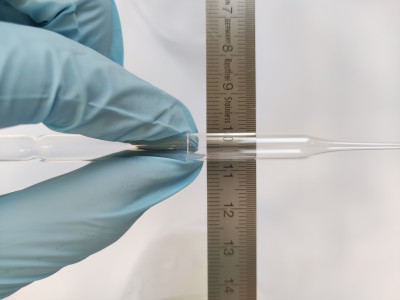News
First single-crystal organometallic perovskite optical fibres
24 September 2022

Due to their very high efficiency in transporting electric charges from light, perovskites are known as the next generation material for solar panels and LED displays. We now have invented a brand-new application of perovskites as optical fibres. The results are published in Science Advances.
Optical fibres are tiny wires as thin as a human hair, in which light travels at a superfast speed – 100 times faster than electrons in cables. These tiny optical fibres transmit the majority of our internet data. At present, most optical fibres are made of glass. The perovskite optical fibre made by Dr Su’s team consists of just one piece of a perovskite crystal. The optical fibres have a core width as low as 50 μm (the size of a human hair) and are very flexible – they can be bent to a radius of 3.5mm.
Compared to their polycrystal counterparts, single-crystal organometallic perovskites are more stable, more efficient, more durable and have fewer defects. Scientists have therefore been seeking to make single-crystal perovskite optical fibres that can bring this high efficiency to fibre optics.
Single-crystal perovskite fibres could be integrated into current fibre-optical networks, to substitute key components in this system – for example in more efficient lasing and energy conversions, improving the speed and quality of our broadband networks.
We were able to grow and precisely control the length and diameter of single-crystal organometallic perovskite fibres in liquid solution (which is very cheap to run) by using a new temperature growth method. They gradually changed the heating position, line contact and temperature during the process to ensure continuous growth in the length while preventing random growth in the width. With our method, the length of the fibre can be controlled, and the cross section of the perovskite fibre core can be varied.
Related article in Science Advances: https://www.science.org/doi/10.1126/sciadv.abq8629
| People: | Lei SU |
| Research Centres: | Bioengineering Sustainable Engineering |
Updated by: Lei Su




